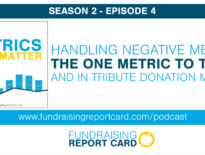Too frequently I receive messages such as this:
Hey Zach, our team is really excited about the Fundraising Report Card. The visuals and dashboards are super clean and good looking. I do have a quick question for you though… how are we supposed to use the reports?
Yes, even after spending two years of my life developing Fundraising Report Card I still receive messages like this. Why? Because data is TOUGH, and making sense of metrics and numbers is no small feat. Plus, sharing charts, reports, and dashboards with your leadership can be intimidating. The thought of crafting a strategy around data can be anxiety inducing. It’s just not that easy.
I know firsthand how challenging the process of becoming data-driven can be—I’ve spent years of my life helping organizations travel down that very path.
Rather than pretend like the problem doesn’t exist I’d like to take some time to address 2 of the outcomes you can (and should) arrive at after analyzing your organization’s fundraising data. It’s not nearly as complicated as you think, and you’ll realize that data isn’t some silver bullet that solves all your problems.
Let’s dive in.
Start a discussion

The first outcome I implore all nonprofit professionals to strive for is to start a discussion. Yes, a simple conversation is one of the best outcomes you can arrive at after analyzing your organization’s fundraising data.
Nothing makes me happier than to hear from a Fundraising Report Card user that leveraged their dashboards as a talking point for an internal meeting. That’s the perfect use case for data visualization.
Data is meant to compliment the decision making process, and to that end, it should drive a discussion. Metrics, reports, and dashboards are not a silver bullet that will solve all of your problems—far from it. Instead, they are guiding lights. The right data at the right time should help provide direction to you and your team during discussion. The opposite holds true just as well. The wrong data at the wrong time can lead you down rabbit holes and eventually become a slippery slope of wasting time.
How then do you know you are talking about the right reports at the right time? It’s not as complicated as you think.
If you’ve made it this far into this blog post I am under the assumption your organization (or at least your team within the organization) is not overly data-driven (that’s why you’re still reading). With that in mind, we’re able to target a few fundamental metrics/reports that most all fundraising teams need and want to review. I wrote an entire book on basic metrics you should measure last year and one section in particular will resonate with you, this one.
Remember, data should be a part of your decision making process. The right data at the right time should serve as a directional tool for your conversations. Yes, one of the best outcomes of data analysis and effective reporting is a productive meeting with your colleagues.
Identify something better to measure

It may be disappointing, but one of the best outcomes you can arrive at after analyzing your organization’s data is to realize that you need to measure a different set of metrics. Frequently I see a lot of nonprofit professionals who believe that measuring one set of metrics (too frequently the first set they come across) is the optimal solution. Odds are it probably isn’t.
Take a look at the list of 9 key fundraising metrics I linked to above. In my eBook I write explicitly that these 9 metrics from chapter 2 are the “key” metrics you should be focusing in on. Secrets out… they aren’t! In order to figure out what your organization’s key metrics are you’ll need to conduct a bit of testing (i.e. trial and error). Although I list 9 key metrics in my book, and I certainly do stand by them, they won’t necessarily (or even likely) be key metrics for your organization. They will point you in the right direction, however, and that is important.
Let’s discuss a tangible example. One of the key fundraising metrics you’ll read about all over the web and hear at conferences is donor retention rate. Donor retention rate is great. It’s a measure of how well you’re building relationships with your constituency. “Awesome, let’s measure it,” you may think to yourself.
After calculating and reviewing your organization’s donor retention rate don’t be surprised if you realize it isn’t the “end all be all” metric you had heard about it. Instead, after scrutinizing donor retention rate you may come to the conclusion that what’s more important to you is knowing how well you’ve built relationships with your volunteers that convert to donors. Instead of measuring overall donor retention rate, you figure out that what you need to focus on is volunteer to donor conversion rate.
Sometimes, and very frequently at the beginning of your analysis journey, you’ll end up measuring one metric, only to realize that it isn’t quite what you need to help guide the decision making process.
Here at MarketSmart it took me weeks to finally distill our key performance indicator dashboard down to the few key metrics I truly need to measure. The same process will happen on your end too. Start with the 9 key metrics I described above and be willing (and appreciative) when you hit a brick wall.
One of the successful outcomes of analyzing data is simply realizing that what you analyzed isn’t exactly what you need.
Applying this at your shop
As you can see, data isn’t the end all be all. Don’t let fancy jargon or intimidating equations stop you from being data-driven.
Having a discussion with your team regarding trends in a report is a perfectly acceptable and beneficial outcome from measuring fundraising metrics. Realizing that what you were analyzing and measuring isn’t quite what you need to make better decisions is also a fine (and expected) outcome. Data doesn’t need to be too complex. You have to start somewhere and take ownership of the process. Strive to achieve these two objectives listed above and you’ll be well on your way to making data-driven progress at your organization!




